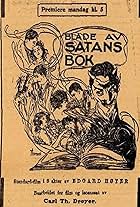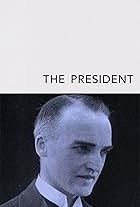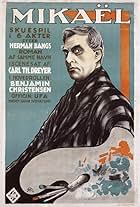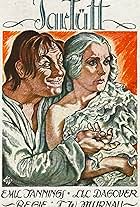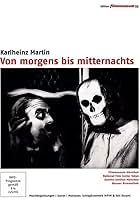IMDb RATING
7.1/10
1.6K
YOUR RATING
A newly elected village parson is required to marry the previous parson's widow. However he's already married, and the woman is old enough to be his grandmother.A newly elected village parson is required to marry the previous parson's widow. However he's already married, and the woman is old enough to be his grandmother.A newly elected village parson is required to marry the previous parson's widow. However he's already married, and the woman is old enough to be his grandmother.
- Director
- Writers
- Stars
- Director
- Writers
- All cast & crew
- Production, box office & more at IMDbPro
Featured reviews
Hildur Carlberg, the skilled septuagenarian actress who plays Dame Margarete, died in August, 1920, two months before this film opened-- a heartbreaking irony, in part because the plot involves her youthful husband marrying her only to await her death.
The film has marvelous comic moments, capitalizing on the fact that medieval European peasants suffered from backbreaking work, a total absence of education, and a desperate need for dentists. The scene when a couple of clerics (the losers) compete for the job of parson by delivering sermons in which they inadvertently skewer their own backwardness is priceless, especially as they are speaking to a congregation of bedraggled and toothless locals who were mostly in church to nap. And the scene where an old lady hocks something out of her nose before returning to her needlepoint-- fabulous.
Dreyer, a committed naturalist who didn't even approve of make-up on his performers, shot this film on location at Maihaugen, Norway, in an open-air museum of 200 medieval buildings. Even the interiors are authentic. Every frame shows it. Watch particularly for a folk wall hanging in Dame Margarete's home. This is another silent gem from the director of The Passion of Joan of Arc.
The film has marvelous comic moments, capitalizing on the fact that medieval European peasants suffered from backbreaking work, a total absence of education, and a desperate need for dentists. The scene when a couple of clerics (the losers) compete for the job of parson by delivering sermons in which they inadvertently skewer their own backwardness is priceless, especially as they are speaking to a congregation of bedraggled and toothless locals who were mostly in church to nap. And the scene where an old lady hocks something out of her nose before returning to her needlepoint-- fabulous.
Dreyer, a committed naturalist who didn't even approve of make-up on his performers, shot this film on location at Maihaugen, Norway, in an open-air museum of 200 medieval buildings. Even the interiors are authentic. Every frame shows it. Watch particularly for a folk wall hanging in Dame Margarete's home. This is another silent gem from the director of The Passion of Joan of Arc.
Over the mountain wander Sofren and Mari. Sofren is a student of theology come to apply for the vacant position of parson in this rural Norwegian village. Mari is his fiancée, but not yet his wife because her father won't allow it until he becomes a real parson. Luckily for him, his two competitors from Copenhagen aren't particularly up to the task. The first looks like a cross between John Lennon and Bill Gates and bores his audience to sleep, so much so that even the man tasked with keeping everyone awake drops off; and the other is a bloated fool who keeps them amused only because Sofren has stuck a feather to the back of his head.
So Sofren it is: the five bearded elders tasked with the decision don't have much of a task after all, given that he's young and dynamic and can think on his feet. However, there's a catch, for there must always be a catch. The local custom is that the parson's widow comes with the job. This wasn't for any religious reason, merely a practical one because someone has to take care of her, after all, but this particular parson's widow, Dame Margarete Pedersdotter, has outlasted the previous three parsons only to be handed over each time to their successors 'like a piece of furniture'.
And just as Sofren had no problem outsmarting his rivals, who run for the hills the moment they see Dame Margarete anyway, the parson's widow outsmarts Sofren. Eager to retain her position running the parson's house, she persuades him subtly to propose. There's mention that she may be a witch but she really accomplishes it with a herring and a bottle of schnapps. So Sofren becomes the parson and Dame Margarete becomes the parson's wife once more, mistress of her whole domain. And with this setup, with Mari introduced into the mix as Sofren's sister rather than his fiancée, naturally hilarity ensues.
Well hilarity is a strong term, given that this is a Swedish silent film from 1920 and a Carl Theodor Dreyer movie to boot, but it's a lot closer to hilarity than I'd have ever imagined for one of his films. I've seen a lot of them, having been utterly stunned by The Passion of Joan of Arc and fascinated into finding as much of the rest of his work that I could. This was the second film Dreyer directed, but the eighth of his fourteen feature length movies for me. It's the first to invoke laughter, which comes about mostly in a subtle way but with some stooping to pantomime, such as the scenes where Sofren prances around in an elaborate Satan suit after he becomes convinced that his wife is a witch.
It's constructed well, with strong performances and memorable characters, varied shots and varied expectations. It looks good, whether inside or out, and there's a lot of use of the common silent film masking technique that turns the screen into a small circle to highlight what we should be looking at. As would fit a story built around a folk custom, there's a great deal here that speaks to customs and folklore, from dances to rituals to beliefs. Quite which Scandinavian culture or cultures this applies to, I'm not sure, given that it's a Swedish film set in Norway but based on a Danish story, but they're fascinating.
And backing up Dreyer's direction, Dreyer being a man who controlled his films as surely as Dame Margarete controls her household, are a number of memorable performances. Einar Röd plays Sofren as something of an imp. We rarely see him in church, this being one of the least religious religious films I've ever seen. Instead we watch him try all sorts of hare brained schemes to try to see his Mari, always coming up short but learning something in the process, there very much being a lesson here in and amidst the comedy. Greta Almroth is a wholesome but frustrated Mari, reminding a little of Elsa Lanchester.
Best of all is Hildur Carlberg as Dame Margarete, dominant throughout but always human. Born as far back as 1843, she was 76 when she made this film, her third and last. With a memorable face with many lines showing her age and a memorable gait that would have made her a prime candidate for a major role in a zombie movie, it's sad that she wouldn't make any more. She died two months before this film was released. I wonder if they nailed a horseshoe above her door and sprinkled linseed oil on the ground to ensure she didn't come back to haunt her house.
So Sofren it is: the five bearded elders tasked with the decision don't have much of a task after all, given that he's young and dynamic and can think on his feet. However, there's a catch, for there must always be a catch. The local custom is that the parson's widow comes with the job. This wasn't for any religious reason, merely a practical one because someone has to take care of her, after all, but this particular parson's widow, Dame Margarete Pedersdotter, has outlasted the previous three parsons only to be handed over each time to their successors 'like a piece of furniture'.
And just as Sofren had no problem outsmarting his rivals, who run for the hills the moment they see Dame Margarete anyway, the parson's widow outsmarts Sofren. Eager to retain her position running the parson's house, she persuades him subtly to propose. There's mention that she may be a witch but she really accomplishes it with a herring and a bottle of schnapps. So Sofren becomes the parson and Dame Margarete becomes the parson's wife once more, mistress of her whole domain. And with this setup, with Mari introduced into the mix as Sofren's sister rather than his fiancée, naturally hilarity ensues.
Well hilarity is a strong term, given that this is a Swedish silent film from 1920 and a Carl Theodor Dreyer movie to boot, but it's a lot closer to hilarity than I'd have ever imagined for one of his films. I've seen a lot of them, having been utterly stunned by The Passion of Joan of Arc and fascinated into finding as much of the rest of his work that I could. This was the second film Dreyer directed, but the eighth of his fourteen feature length movies for me. It's the first to invoke laughter, which comes about mostly in a subtle way but with some stooping to pantomime, such as the scenes where Sofren prances around in an elaborate Satan suit after he becomes convinced that his wife is a witch.
It's constructed well, with strong performances and memorable characters, varied shots and varied expectations. It looks good, whether inside or out, and there's a lot of use of the common silent film masking technique that turns the screen into a small circle to highlight what we should be looking at. As would fit a story built around a folk custom, there's a great deal here that speaks to customs and folklore, from dances to rituals to beliefs. Quite which Scandinavian culture or cultures this applies to, I'm not sure, given that it's a Swedish film set in Norway but based on a Danish story, but they're fascinating.
And backing up Dreyer's direction, Dreyer being a man who controlled his films as surely as Dame Margarete controls her household, are a number of memorable performances. Einar Röd plays Sofren as something of an imp. We rarely see him in church, this being one of the least religious religious films I've ever seen. Instead we watch him try all sorts of hare brained schemes to try to see his Mari, always coming up short but learning something in the process, there very much being a lesson here in and amidst the comedy. Greta Almroth is a wholesome but frustrated Mari, reminding a little of Elsa Lanchester.
Best of all is Hildur Carlberg as Dame Margarete, dominant throughout but always human. Born as far back as 1843, she was 76 when she made this film, her third and last. With a memorable face with many lines showing her age and a memorable gait that would have made her a prime candidate for a major role in a zombie movie, it's sad that she wouldn't make any more. She died two months before this film was released. I wonder if they nailed a horseshoe above her door and sprinkled linseed oil on the ground to ensure she didn't come back to haunt her house.
In order to take on the previous incumbent's living, a young clergyman has also to take on the deceased man's widow, which is a trifle inconvenient as said parson is in love with another. The parson in question is in also competition with two other 'academic' types who are treated with scorn and ridicule due to the quality (or lack of it) of their sermons. What starts off rather cruelly, with the young lovers waiting for the old woman to die, develops into a moving human story, although it does flag a little in spots. The latter scenes of the widow saying 'good-bye' to her surroundings and people when she feels she is to die soon is particularly moving and powerful. Ironically, life imitated art as Hildur Carlberg, who played the widow, died shortly afterwards, though several of her listed films are fortunately still around. Mathilde Nielsen, who played the tyrannical nurse in Dreyer's Master of the House, plays one of the widow's servants.
Certainly recommended to those fearing an hour or so with Mr Dreyer to be an austere and dreary prospect, this film also has an admirable period feel to it, though some of this is perhaps due to the use of unfamiliar (to me, at least) faces.
Certainly recommended to those fearing an hour or so with Mr Dreyer to be an austere and dreary prospect, this film also has an admirable period feel to it, though some of this is perhaps due to the use of unfamiliar (to me, at least) faces.
I do not know if Dreyer's first feature, "The President" was a big hit, to speculate if he had strong doubts about what his next films would be. In any case, it did not take long before he started shooting again, for the next year he released "Leaves Out of the Book of Satan" and next "The Parson's Widow", a production made and financed in Sweden. The story tells how a young man, when selected as the new parson of a community, marries his predecessor's old widow (who claims her right to do so), but brings along his own fiancée to live with them, making her pass as his sister. There is opportunism on both the parson's and the widow's sides, but this being a comedy these matters are treated lightly, as are eluded reflections on the options we may have in old age or youth, when facing the possibility of losing everything, as in the widow's case, or the shaping of a career and a happy life, in the young man's. Yet this is a strange comedy, for melancholy is always present, mainly reflected on the old but still beautiful and dignified face of actress Hildur Carlberg; and if it is true that Dreyer was not intent on making an ethnographic treatise, one of the most interesting aspects of his film is the portrait of rural settings, customs and rites, as religious sermons, feasts, weddings and funerals. If you ask me I prefer "The President" to this film, but it was a firm step in the filmography of the creator of "The Passion of Jeanne d'Arc", "Vampyr" and "Ordet".
I haven't seen Carl Theodor Dreyer's directorial début, "The President" (Præsidenten), yet. I've seen "Leaves from Satan's Book" (Blade af Satans Bog), however, and it was totally unimpressive. Dreyer took from Griffith's "Intolerance", but didn't even manage a simulacrum of the American director's craft. "The Parson's Widow" is a much better beginning for Denmark's great filmmaker. It is the work of a director coming into his own, even though it's much different in some ways from the rest of his oeuvre.
As with "Leaves from Satan's Book" and his later films, there's the preoccupation with history and religion. But, as others agree, this is Dreyer light. The story of a man who must marry a hag to become a village's parson, and his plots to marry his young fiancée and keep the job despite it is amusing. I thought the devil costume bit was particularly humorous. Dreyer's direction is what makes this worthwhile, though. The quick pace, not lingering on shots and improved camera positioning compared to "Leaves from Satan's Book" make this film more accessible and entertaining.
Dreyer again uses masking and fades extensively, but this time it adds to the style. He gets the most out of the actors. (It shouldn't be underestimated how quicker shot succession can improve, or detract from, otherwise unremarkable acting.) Additionally, the introduction to the past through the waterfall was an especially nice touch. The confining location sets, and more importantly, how Dreyer and cinematographer George Schnéevoigt film them also add greatly to this tightly told film. The small church full of dividers is just a great find, and they use the spaces of the home of the parson's wife very well, with camera placement and continuity editing.
As with "Leaves from Satan's Book" and his later films, there's the preoccupation with history and religion. But, as others agree, this is Dreyer light. The story of a man who must marry a hag to become a village's parson, and his plots to marry his young fiancée and keep the job despite it is amusing. I thought the devil costume bit was particularly humorous. Dreyer's direction is what makes this worthwhile, though. The quick pace, not lingering on shots and improved camera positioning compared to "Leaves from Satan's Book" make this film more accessible and entertaining.
Dreyer again uses masking and fades extensively, but this time it adds to the style. He gets the most out of the actors. (It shouldn't be underestimated how quicker shot succession can improve, or detract from, otherwise unremarkable acting.) Additionally, the introduction to the past through the waterfall was an especially nice touch. The confining location sets, and more importantly, how Dreyer and cinematographer George Schnéevoigt film them also add greatly to this tightly told film. The small church full of dividers is just a great find, and they use the spaces of the home of the parson's wife very well, with camera placement and continuity editing.
Did you know
- Quotes
Dame Margarete: [to Sofren] I suggest you concentrate on prayers and sermons. Do not play master here. I am master of this house!
- Alternate versionsIn 2003, Film Preservation Associates, Inc. copyrighted a version with a piano score compiled and performed by Neal Kurz from the works of Edvard Grieg. It was produced for video by David Shepard and runs 71 minutes.
- ConnectionsFeatured in Carl Th. Dreyer (1966)
Details
- Runtime1 hour 34 minutes
- Color
- Sound mix
- Aspect ratio
- 1.33 : 1
Contribute to this page
Suggest an edit or add missing content













